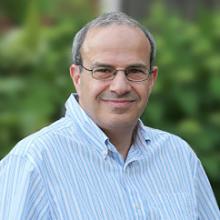There's No conflict between lack of evidence of string theory and work being done on it - Nathan Seiberg
The following interview was conducted by The Wire Science and has been republished in part with written permission. Read the full interview here.
The link for the lecture mentioned in the interview is here
At an event organised by the International Centre for Theoretical Sciences, Sandhya Ramesh caught up with Nathan Seiberg for an interview for The Wire. Seiberg is a string theorist at the Institute for Advanced Studies, Princeton. His work includes fundamental contributions to the development of string theory and improving our understanding of quantum field theory. Among other honours, Seiberg received the prestigious Dirac Medal in 2016.
Sandhya Ramesh: How would you define string theory for a layperson?
Nathan Seiberg.: It’s a very ambitious attempt to find a complete theory of the universe, including all forces, all particles, and space and time. This is a long endeavour that has been going on for a long time and will continue to do so. It’s not something to be judged based on our success in the last quarter [century]. And the perspective on what it is and how to think about it has been changing over the years. I have no doubt it will continue to change, but I’m also confident that we’re making a lot of progress. It’s very exciting.
S.R.: What’s your opinion on reconciling the lack of any experimental evidence of string theory and the intense amount of theoretical work being done on it?
N.S.: It’s not reconciliation. There are two correct statements. One is that at the moment there is no experimental evidence. We don’t know when the verification will come or where it will come from. Maybe someone smart will figure it out next year, maybe it will take three years, maybe 300. We don’t know. The other thing is that there is some effort going into it. You can ask whether it is justified. And I can justify it on several fronts.
First, this is a very exciting intellectual effort and is as such worth pursuing. Second, it has given a lot of options to other branches of science, including condensed matter physics, ideas in astrophysics and cosmology, all the way to completely revolutionising ideas in pure mathematics. This means two different things: 1. This effort has already paid off, “paid off” by the standard criterion of having an impact on other things. 2. I think this is more important: Whenever you work on something and try to solve one problem, and you end up helping or solving many other problems, it is a sign that what you are doing is good.
Because historically this is the way it has worked. For example, Columbus tried to find India and ended up solving a much bigger problem. Other places like people working on quantum mechanics for the sake of understanding what matter is made of, and all modern technology including computers came out of it. This was the original intent. So when you work towards something with a long term goal and along the way you have all these options, a) the option has already been paid for, and b) it is a sign that it’s worth pursuing this work.
I don’t think there is anything to reconcile here because there is no conflict.
S.R.: When theoretical physicists try to explain ‘n’ dimensions, their typical example is ants walking on a wire. What is your favourite way to do this?
N.S.: I don’t have a favourite way (laughs). I use the same metaphor that you used, which is ants walking on a wire or a balloon. I don’t think anyone, including the most powerful mathematically minded people, can really visualise more dimensions. So it’s not that we can visualise and laypeople can’t. It has nothing to do with imagination. We have mathematical formulas that allow us to think about it. All these metaphors are only so good; they are never perfect. It’s a deficiency that we don’t have a better way of expressing and visualising. It’s a problem even for us. We just have to live with that. No one promised it would be easy.
S.R.: Do string theorists work on string theory itself or more on string-theory-inspired subjects? What do you think about this for the future?
N.S.: You found the right person. Of all the people who work on string theory here, I am very much interested in quantum field theory. A lot of that was motivated by string theory. A lot of work I do now has been a part of the work I’ve done on string theory, but a lot of the problems I solve today can be explained and answered without ever mentioning string theory. You can’t say this is strings and that isn’t. Different branches of the sciences are intrinsically connected. It is often the case that ideas in one branch influence other branches. So when we try to put people in boxes (“this person does condensed matter physics”), it becomes too narrow a view. In my understanding, especially here at ICTS, one of the visions is the unity of science. Different fields come together and people interact with each other, both to exchange ideas and for collaborations. It’s a very stimulating environment.
S.R.: Would you say the future lies in interdisciplinary work?
N.S.: I wouldn’t say ‘interdisciplinary’. There isn’t work being done on say string theory and climate science; they are too far apart. But there are neighbouring fields and in multiple such interfaces there are such interactions. Whenever it has happened, it has been very fruitful to both sides. We don’t know how the fields will evolve and which ideas will influence the future. I think it’s reasonable to expect that there will be such collaborative work and an institute that encourages it will be perfect.
The rest of the interview can be found here.


